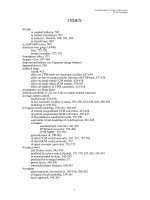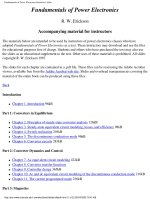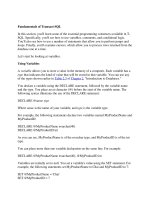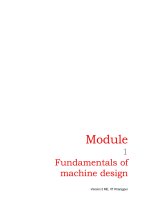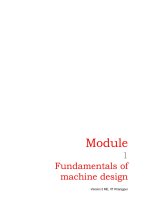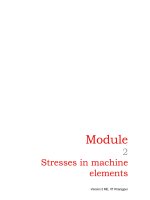Tài liệu FUNDAMENTALS OF METAL CASTING ppt
Bạn đang xem bản rút gọn của tài liệu. Xem và tải ngay bản đầy đủ của tài liệu tại đây (335.25 KB, 10 trang )
1
1
FUNDAMENTALS OF
METAL CASTING
0. Phase Diagram
1. Overview
2. Heating & Pouring
3. Solidification and Cooling
2
0. Alloys and Phase Diagram
• Pure Metals
• Alloys
– Solid solutions
• Substitutional Solid Solution (Zn/Cn and Cu/Ni)
– Atomic radii is similar
– Lattice type is the same
• Interstitial Solid Solution
– Smaller atoms are interstitially located among
bigger atoms
– Lattice type usually does not change
– Intermediate Phases – The solubility of one
element in another element is limited.
• Metallic compounds (Fe
3
C)
• Intermetallic compounds(Mg
2
Pb)
Substitutional
Solid Solution
Interstitial
Solid Solution
3
Cu-Ni Phase Diagram
1000
1200
1400
1600
26%
36%
62%
50%
1260
(°C)
Cu Ni
Liquid
Solid
L+S
Substitutional Solid Alloys
Pure Metals
Pure Metals
Time
T
Time
T
T
Time
L
S
4
Pb-Sn Phase Diagram
Pb (lead)
Sn (Tin)
Temperature, °F
0
100
200
300
400
500
600
α
α+L
L
β+L
β
α+β
362 °F
61.9% Sn
Eutectic Composition
and Temperature
Time
α
5
Fe-C Phase Diagram
200
600
1000
1400
1800
1
23
45
6
Fe C
α+θ
α
γ+θ
γ
L
δ
1130
723
γ+L
L+θ
6
Introduction
• Dated back 6000 years
• Ingot vs. Shape casting
• Polymers and ceramics are cast as well.
• Issues in casting
– Flow
– Heat Transfer
– Selection of Mold Materials
– Solidification- Nucleation and Growth
• Depending on how we control solidification, these
events influence the size, shape, uniformity and
chemical composition of the grains.
2
7
Introduction
• Casting (process) – melt the metal, pour into a
mold by gravity or other force and solidify.
• Casting (Part)
• Advantages
– Complex geometries – external and internal
– Can be net-shaped or near net-shaped
– Can produce very large parts
– Any metals
– Can be mass-produced
– Size variety – big and small
• Disadvantages
– Limitation in mechanical properties, porosity,
– Dimensional accuracy, surface finish
– Safety Hazard
– Environmental problems
8
Classification
Solidification
Process
Metal casting
Glassworking
Polymers & PMC
Processing
Expandable-mold
Casting
permanent-mold
Casting
Extrusion
Injection Molding
Other Molding
Special Molding
for PMC
Shell Molding
Sand Casting
Vacuum Molding
Expanded Polystyrene
Investment Casting
Plaster-Mold Casting
Ceramic-Mold Casting
Permanent-Mold Casting
Variations of
Permanent-Mold Casting
Die Casting
Centrifugal Casting
9
1. Overview
• A Foundry is a casting factory which equipped for
making molds, melting and handling molten metal,
performing the casting process, and cleaning the
finished casting
– Foundrymen are workers.
• Open Molds – Simple parts
• Closed Molds – Complex parts.
– A passageway - the gating system leading into the cavity
• Two categories -Expandable or permanent molds.
(b) closed mold
(a) open mold
10
Two Main Categories
1. Expendable mold processes –A mold after process
must be destroyed in order to remove casting
– Mold materials: sand, plaster and similar materials +
binders
– More intricate geometries
2. Permanent mold processes –A mold can be used
many times to produce many castings
– Mold: made of metal and, less commonly, a ceramic
refractory material
– Part shapes are limited
– Permanent mold processes are more economic in high
production operations
11
Basic features of Molds
• Sand Casting Molds
– Mold: cope (upper half) &
drag (bottom half)
– Flask - containment
– Parting line
– Pattern – the mold cavity
– The gating system – pouring
cup, (down)sprue, runner
– Riser – a source of liquid
metal to compensate for
shrinkage during solidification
Cope
Drag
Flask
Parting
line
Mold
Pouring
cup
Downsprue
Runner
Core
Riser
12
Casting Processes
• Forming the Mold Cavity
– Mold cavity is formed by packing sand around a pattern.
– The pattern usually oversized for shrinkage is removed.
– Sand for the mold is moist and contains a binder to maintain shape
• Cores in the Mold Cavity
– The mold cavity - the external surfaces of the cast part
–A core, placed inside the mold cavity to define the interior
geometry of part. In sand casting, cores are made of sand.
• Gating System - Channel through which molten metal
flows into cavity
– A downsprue, through which metal enters a runner
– At top of downsprue, a pouring cup to minimize splash and
turbulence
• Riser - Liquid metal reservoir to compensate for shrinkage
during solidification
– The riser must be designed to freeze after the main casting
solidify.
3
13
2. Heating & Pouring
• Sufficient to melt and raise the molten metal to a right
state
• Total Heat Energy required:
H=ρV[C
s
(T
m
-T
o
)+H
f
+C
l
(T
p
-T
m
)]
where ρ=density, V=volume, C
s
=specific heat for solid
C
l
=specific heat for liquid, T
m
=melting temperature
T
o
=starting temperature, T
p
=pouring temperature
• Factors affecting ‘pouring’
– Pouring temperature (vs. melting temp.)
– Pouring rate
• Too slow, metal freezes
• Too high, turbulence
– Turbulence
• Accelerate the formation of oxides
• Mold erosion
•Voids?
14
Pouring Analysis
• Bernoulli’s theorem at any two points in a flowing
liquid
• h=head, P=pressure, ρ=density, v=flow velocity, g=gravity, F=friction loss
– Assuming no frictional loss and same pressure
– Assuming point 2 is reference (h
2
=0) and v
1
=0,
• Continuity law
• Mold fill time (MFT)
2211
AvAvQ ==
g
vP
h
g
vP
h
22
2
22
2
2
11
1
++=++
ρρ
g
v
h
g
v
h
22
2
2
2
2
1
1
+=+
12
2
2
1
2;
2
ghv
g
v
h ==
Q
V
MFT =
1
2
15
Fluidity
• Fluidity:
A measure of the capability of a metal to flow into and fill the mold
before freezing.
(
Inverse of viscosity)
• Factors affecting fluidity -
Pouring temperature, Metal composition, Viscosity,
Heat transfer to the surroundings, Heat of fusion and Solidification
• Higher Re, greater tendency for turbulence flow
– Turbulence and laminar flow
Reynold’s number: Re=vDr/h
Re ranges 2,000(laminar) to 20,000 (mixture of laminar-turbulence)
greater than 20,000 turbulence resulting in air entrainment and dross
(scum) formation
• Minimize turbulence by avoiding a certain range in flow direction
Pure metals: good fluidity
Alloys: not as good
Tests for fluidity [Schey, 2000]
16
3. Solidification(Pure Metals)
Transformation of molten metal
into solid state
• Solidification differs
depending on a pure
element or an alloy
• For Pure Metal
– Super(Under)cooling
– Solidification occurs at a
constant temperature and
supercooled Temperature
– Actual freezing during the local
solidification time
Time
Temperature
Total solidification time
T
m
Freezing
temperature
Pouring
temperature
Liquid cooling
Solid cooling
Local
solidification
time
Pure Metals
17
Solidification of Pure Metals
• A thin skin of solid metal is
formed at the cold mold wall
immediately after pouring
• Skin thickness increases to form
a shell around the molten metal
as solidification progresses
• Rate of freezing depends on
heat transfer into mold, as well
as thermal properties of the
metal
Randomly oriented grains of small size
near the mold wall, and large columnar
grains oriented toward the center of the
casting (Dendritic growth)
Temp. Temp.
Slower
Heat Transfer
Temp.
18
Dendrite Growth
L
S
4
19
Solidification of Alloy
• Most Alloys freeze over a temperature range, not at a
single temperature.
• Nucleation
– Energy involved in homogeneous nucleation
– Total free energy change:
where =volume free energy
= radius of embryo
= specific surface free energy
• Chemical compositional gradiency within a single grain
• Chemical compositional gradiency throughout the casting – ingot
segregation
• Eutectic Alloys – Solidification occurs at a single temperature
γππ
23
4
3
4
rGrG
vt
+∆=∆
r*
v
G∆
γ
r
r
t
G∆
20
Solidification of Alloys
cooling curve for a 50%Ni-50%Cu composition during casting
Dendritic
Growth
Time
Temperature
Total solidification time
Freezing
temperature
Pouring
temperature
Liquid cooling
Solid cooling
Ni Cu
L
S
L+S
21
Solidification Time
• Chvorinov’s Empirical relationship: Solidification time
as a function of the size and shape
V=volume A=surface area and n=2
C
m
=experimentally determined value that depends on
mold material, thermal properties of casting metal,
and pouring temperature relative to melting point
• A casting with a higher volume-to-surface area ratio
solidifies more slowly than one with a lower ratio
• Used in riser design: the solidification time of the riser
must be equal to the solidification time of the cast
part.
n
m
A
V
CTST
⎟
⎠
⎞
⎜
⎝
⎛
=
22
Shrinkage
65.5
Bronze
7.54.5
Copper
7.23
Low C Cast Steel
30
Gray Cast Iron
with High C
31.8
Gray cast iron
57
Al alloys
5.6%7%
Aluminum
Thermal
Contraction
Solidification
Metal
Volume Contraction
Simplification
• Exception: cast iron with high C content because of graphitization
during final stages causes expansion that counteracts volumetric
decrease associated with phase change
pattern shrinkage allowance
23
Directional Solidification
• To minimize the damage during casting, the region
most distant from the liquid metal supply needs to
freeze first and the solidification needs to procede
toward the riser.
• Based on Chvorinov’s rule, the section with lower
V/A ratio should freeze first.
• Use ‘Chills’: Internal and External chills which
encourage rapid cooling.
External Chills
Internal Chills
Made of metal
24
METAL CASTING
PROCESSES
1. Sand Casting
2. Other Expandable Mold Casting Processes
3. Permanent Mold Casting Processes
4. Foundry practice
5. Casting Quality
6. Metals for Casting
7. Product Design Consideration
5
25
Introduction
• Casting of Ingot and Shape casting
• Major Classification
– Expandable Mold
• A new mold is required for each new casting
• Production rate is limited except Sand casting
• Sand Casting, Shell Molding, Vacuum Molding, Expandable
Polystyrene, Investment Casting, Plaster Molding, Ceramic
Mold Casting
– Permanent Mold
• Mold is made of durable materials
• Ideal for a product with a high production rate
26
1. Sand Casting
• Most widely used casting process.
• Parts ranging in size from small to very large
• Production quantities from one to millions
• Sand mold is used.
• Patterns and Cores
– Solid, Split, Match-plate and Cope-and-drag Patterns
– Cores – achieve the internal surface of the part
• Molds
– Sand with a mixture of water and bonding clay
– Typical mix: 90% sand, 3% water, and 7% clay
– to enhance strength and/or permeability
27
Molds
• Sand – Refractory for high temperature
• Size and shape of sand
– Small grain size -> better surface finish
– Large grain size -> to allow escape of gases during pouring
– Irregular grain shapes -> strengthen molds due to
interlocking but to reduce permeability
• Types
– Green-sand molds - mixture of sand, clay, and water;
“Green" means mold contains moisture at time of pouring
– Dry-sand mold - organic binders rather than clay and mold is
baked to improve strength
– Skin-dried mold - drying mold cavity surface of a green-sand
mold to a depth of 10 to 25 mm, using torches or heating
lamps
28
Steps in Sand Casting
The cavity in the sand mold is formed by packing sand around a pattern,
separating the mold into two halves
– The mold must also contain gating and riser system
– For internal cavity, a core must be included in mold
– A new sand mold must be made for each part
1. Pour molten metal into sand mold
2. Allow metal to solidify
3. Break up the mold to remove casting
4. Clean and inspect casting
5. Heat treatment of casting is sometimes required to improve metallurgical
properties
29
Types of patterns used in sand
casting:
(a) solid pattern
(b) split pattern
(c) match-plate pattern
(d) cope and drag pattern
30
Internal Cavity with Core
(a) Core held in place in the mold cavity by chaplets
(b) possible chaplet design
(c) casting with internal cavity
6
31
Desirable Mold Properties and
Characteristics
• Strength - to maintain shape and resist erosion
• Permeability - to allow hot air and gases to pass
through voids in sand
• Thermal stability - to resist cracking on contact
with molten metal
• Collapsibility - ability to give way and allow
casting to shrink without cracking the casting
• Reusability - can sand from broken mold be
reused to make other molds?
32
2. Other Expendable Mold Casting
• Shell Molding
• Vacuum Molding
• Expanded Polystyrene Process
• Investment casting
• Plaster and Ceramic Mold casting
33
Steps in shell-molding
34
Shell Molding
• Advantages:
– Smoother cavity surface permits easier flow of molten
metal and better surface finish on casting
– Good dimensional accuracy
– Machining often not required
– Mold collapsibility usually avoids cracks in casting
– Can be mechanized for mass production
• Disadvantages:
– More expensive metal pattern
– Difficult to justify for small quantities
35
Expanded Polystyrene Casting
36
Expanded Polystyrene Casting
• Advantages:
– Pattern need not be removed from the mold
– Simplifies and expedites mold-making, since two
mold halves (cope and drag) are not required as in a
conventional green-sand mold
– Automated Mass production of castings for
automobile engines
• Disadvantages:
– A new pattern is needed for every casting
– Economic justification of the process is highly
dependent on cost of producing patterns
7
37
Investment Casting
38
Investment Casting
• Advantages:
– Parts of great complexity and intricacy can be cast
– Close dimensional control and good surface finish
– Wax can usually be recovered for reuse
– Additional machining is not normally required - this is
a net shape process
• Disadvantages
– Many processing steps are required
– Relatively expensive process
39
Plaster Molding
• Similar to sand casting except mold is made of plaster of
Paris (gypsum - CaSO4-2H2O)
• Plaster and water mixture is poured over plastic or metal
pattern to make a mold
• Advantages:
– Good dimensional accuracy and surface finish
– Capability to make thin cross-sections in casting
• Disadvantages:
– Moisture in plaster mold causes problems:
• Mold must be baked to remove moisture
• Mold strength is lost when is over-baked, yet moisture content can
cause defects in product
– Plaster molds cannot stand high temperatures
40
3. Permanent Mold Casting
• Basic Permanent Mold Process
– Uses a metal mold constructed of two sections
designed for easy, precise opening and closing
– Molds for lower melting point alloys: steel or cast
iron and Molds for steel: refractory material, due to
the very high pouring temperatures
• Variations
– Slush Casting
– Low-pressure Casting
– Vacuum Permanent Mold Casting
• Die Casting
• Centrifugal Casting
41
Permanent Mold Casting
Process
• Metals - Al, Mg, Copper alloy and Cast Iron
• Basic Steps
– Preheated Mold (metals to flow)
– Coatings are sprayed
– Pour and solidify
– Mold is open and casting is removed
• Advantage - Good surface finish and dimensional
control and Fine grain due to rapid solidification.
• Disadvantage - Simple geometric part, expensive
mold.
• Example - automobile piston, pump bodies
castings for aircraft and missiles.
42
Basic Permanent Mold Process
8
43
Permanent Mold Casting
• Advantages:
– Good dimensional control and surface finish
– More rapid solidification caused by the cold metal
mold results in a finer grain structure, so stronger
castings are produced
• Limitations:
– Generally limited to metals of lower melting point
– Simple part geometries compared to sand casting
because of the need to open the mold
– High cost of mold
• Due to high mold cost, process is best suited to
automated high volume production
44
Die Casting
• The molten metal is injected into mold cavity
(die) under high pressure (7-350MPa).
Pressure maintained during solidification.
• Hot Chamber (Pressure of 7 to 35MPa)
– The injection system is submerged under the molten
metals (low melting point metals such as lead, zinc,
tin and magnesium)
• Cold Chamber (Pressure of 14 to 140MPa)
– External melting container (in addition aluminum,
brass and magnesium)
45
Die Casting
• Molds are made of tool steel, mold steel,
maraging steel, tungsten and molybdenum.
• Single or multiple cavity
• Lubricants and Ejector pins to free the parts
• Venting holes and passageways in die
• Formation of flash that needs to be trimmed
• Advantages
– High production, Economical, close tolerance, good
surface finish, thin sections, rapid cooling
46
Hot-Chamber Die Casting
47
Cold Chamber Die Casting
48
Die Casting
• Advantages:
– Economical for large production quantities
– Good dimensional accuracy and surface finish
– Thin sections are possible
– Rapid cooling provides small grain size and good
strength to casting
• Disadvantages:
– Generally limited to metals with low metal points
– Part geometry must allow removal from die cavity
9
49
Centrifugal casting
• True centrifugal casting
• Semicentrifugal casting
• Centrifuge casting
50
4. Foundry Practice
• Furnace
– Cupolas (Fig. 11.18)
– Direct Fuel-fired furnace
– Crucible Furnace (Fig. 11.19)
– Electric-arc Furnace
– Induction Furnace
• Pouring with ladle
• Solidification – watch for oxidation
• Trimming, surface cleaning, repair and heat
treat, inspection
51
Three types : (a) lift-out crucible, (b) stationary pot, from which molten
metal must be ladled, and (c) tilting-pot furnace
Electric Arc Furnace
Induction furnace
52
5. Casting Quality
• Casting defects
a) Misruns
b) Cold shut
c) Cold shots
d) Shrinkage cavity
e) Microporosity
f) Hot Tearing
53
Sand Mold defects
(d) Scabs
(c) Sand wash
(g) Core shift
(b) Pin hole
(h) Mold crack
(e) Penetration
(f) Mold shift
54
6. Metals for Casting
• Ferrous casting alloys: cast iron
– Gray Cast Iron, Nodular iron, White Cast Iron, Malleable
Iron, Alloy cast iron
• Ferrous casting alloys: Steels
– Melting temperature is higher that casting alloys. Thus they
are more reactive.
– Less Fluidity
– Higher strength, Tougher
– Isotropy and weldable
• Nonferrous casting alloys
– Aluminum, Magnesium, Copper, Tin-based, Zinc, Nickel and
Titanium Alloys
10
55
7. Product Design Considerations
• Geometric simplicity
•Corners
• Section thicknesses – Hot spot
• Draft (Fig. 11.25)
•Use of Cores
• Dimensional tolerances and surface finish
• Machining allowance
• Tolerance and Surface Roughness for Various Casting
Processes
– See Table 11.2


